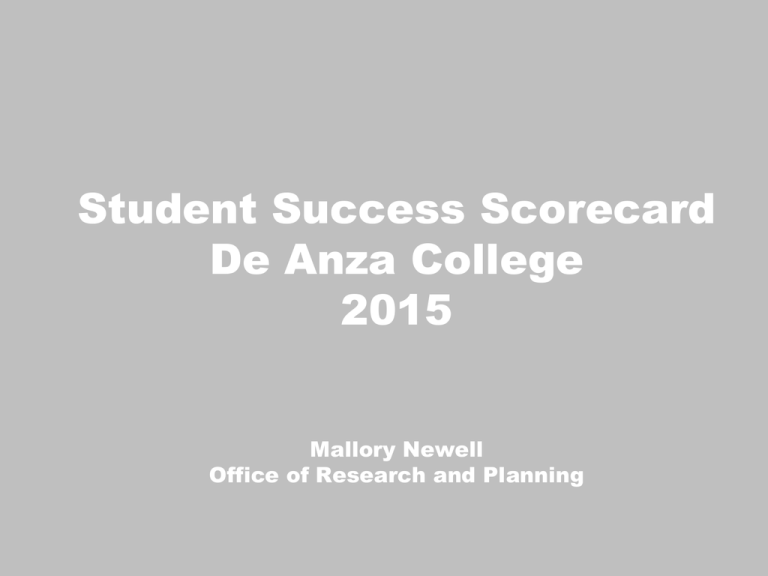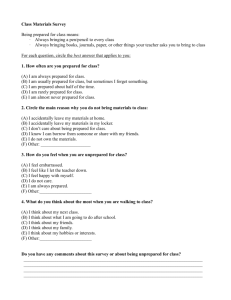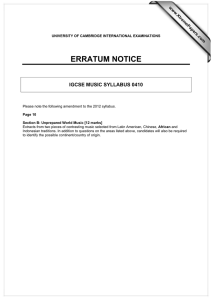Student Scorecard Presentation - Fall 2015
advertisement

Student Success Scorecard De Anza College 2015 Mallory Newell Office of Research and Planning Intermediary Metrics Remedial Completion • English • Math • ESL Complete 30 units on way to degree or transfer Four quarter persistence Outcome Metrics Completion • Overall • Prepared • Unprepared CTE Completion Current Rate Completion State Avg. Peer High + 20.5% + 3.3% + 14.6% + 5.6% 5-Year Trend 67.3% (3,457) Completion Prepared 84.3% Completion Unprepared 60.3% (1,006) (2,451) + 21.1% + 9.4% Percentage of degree, certificate and/or transfer-seeking students starting first time, tracked for six years who completed a degree, certificate or transfer-related outcomes. Peer groups are based on 24 other college with similar institutional and student characteristics: http://extranet.cccco.edu/Portals/1/TRIS/Research/Accountability/ARCC2_0/Peer_groups_final.pdf . 5-year trends include 2004-05 to 2008-09. Current Rate English + 22.8% 46.5% (908) CTE + 29.7% 53.8% (2,358) ESL 5-Year Trend 73.1% (2,045) Math State Avg. + 18.1% 54.7% (3,175) + 4.8% Remedial: % of degree credits students tracked for six years who first enrolled in a basic skills course and completed a college level course. CTE: % of students completing more than 8 CTE units, tracked for 6 years who complete a degree, certificate or transfer-related outcome. 5year trends include 2004-05 to 2008-09. Completion Rate – Overall – By Ethnicity Asian White (1,408) (771) 80 in 100 complete 65 in 100 complete Filipino (224) 55 in 100 complete Pacific Islander (41) 54 in 100 complete African American (139) 60 in 100 complete Latino/a (569) 45 in 100 complete Completion Rate - Latino/a Students Prepared Latinos All Latinos 69% (35/51) 46% (263/569) Unprepared Latinos 44% (228/518) Lowest performing Latino groups 27% 23% 22% Male, 20-24 yrs. old 4/14 complete Female, 25-39 yrs. old 3/13 complete Female, 20-24 yrs. old 4/18 complete Prepared All Latinos 69% What If Scenario: How much would we increase our Unprepared Completion Rate by moving the lowest achieving students (45) to the rate of other Unprepared Latino/a students? (35/51) By moving these 9 students from unsuccessful to successful, 46% we increase our Completion Rate for Latino students by 2%. Unprepared 46% Unprepared Completion Rate = 44% (263/569) 44% 28% Male, 20-24 yrs. old 4/14 complete 23% Female, 25-39 yrs. old 3/13 complete 22% Female, 20-24 yrs. old 4/18 complete (228/518) By moving 9 students from unsuccessful to successful, we would increase our Unprepared Latino Completion Rate by 2%. Completion Rate - African American Students Prepared All African Americans Students 82% (14/17) 59% (82/139) Unprepared 56% (68/122) Lowest performing African American Groups 54% 43% 40% Male, Less than 20 25/46 complete Female, 20-39 yrs. old 6/14 complete Male, 20-39 yrs. old 6/15 complete Prepared All African Americans 82% What If Scenario: How much would we increase our Unprepared Completion Rate by moving the lowest achieving students (75) to the rate of other Unprepared African American students? (14/17) By moving these 6 students from unsuccessful to successful, 59% 59% it increases Unprepared our Completion Rate for African Americans by 4.3%. (82/139) 56% Unprepared Completion Rate = 56% (68/122) By moving 6 students from unsuccessful to successful we would increase our Unprepared Completion Rate by 4.7%. 54% Male, Less than 20 25/46 complete 43% Female, 20-39 yrs. old 6/14 complete 40% Male, 20-39 yrs. old 6/15 complete Implications and Considerations - Small changes can move the needle by a lot! - Are ‘Unprepared’ students correctly placed? - What would their success rates be if they were placed at college level? - What projects or initiatives should we focus on to close the achievement gap? - How committed are we to closing the achievement gap? - We will need to challenge our culture and current systems, including: - Culture of student failure vs. our own failure - Placement processes - Basic skills sequences - Pre-requisites - Support services


